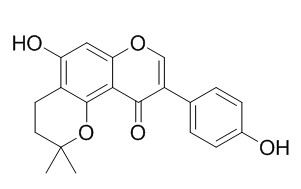Providing storage is as stated on the product vial and the vial is kept tightly sealed, the product can be stored for up to
24 months(2-8C).
Wherever possible, you should prepare and use solutions on the same day. However, if you need to make up stock solutions in advance, we recommend that you store the solution as aliquots in tightly sealed vials at -20C. Generally, these will be useable for up to two weeks. Before use, and prior to opening the vial we recommend that you allow your product to equilibrate to room temperature for at least 1 hour.
Need more advice on solubility, usage and handling? Please email to: service@chemfaces.com
The packaging of the product may have turned upside down during transportation, resulting in the natural compounds adhering to the neck or cap of the vial. take the vial out of its packaging and gently shake to let the compounds fall to the bottom of the vial. for liquid products, centrifuge at 200-500 RPM to gather the liquid at the bottom of the vial. try to avoid loss or contamination during handling.
Pakistan Journal of Biological Sciences, 2011, 14(10):560-571.
Assessing Sub-saharian Erythrina for Efficacy: Traditional uses, Biological Activities and Phytochemistry.[Reference:
WebLink]
METHODS AND RESULTS:
The genus Erythrina comprises more than 100 species, widely distributed in tropical and subtropical areas. In Africa, 31 wild species and 14 cultivated species have been described. In sub-Saharan Africa, Erythrina species are used to treat frequent parasitic and microbial diseases, inflammation, cancer, wounds. The rationale of these traditional uses in African traditional medicine was established by screening several species for biological activities. Promising activities were found against bacteria, parasites (Plasmodium), human and phytopathogenic fungi, some of which were multidrug resistant (MDR) micro organisms. Some species also exhibited antioxidant, anti-inflammatory activities and enzymes inhibitory properties. Most of the species chemically investigated were reported to contain flavanones, prenylated isoflavones, isoflavanones(alpha-Isowighteone
) and pterocarpans. Some phytochemicals (vogelin B, vogelin C, isowightcone, abyssinin II, derrone) were the active principles as antibacterials, antifungals, antiplasmodials and inhibitors of enzyme borne diseases (PTP1B, HIV protease, DGAT).
CONCLUSIONS:
This review highlights the important role of Erythrina species as sources of lead compounds or new class of phytotherapeutic agents for fighting against major public health (MDR infections, cancer, diabetes, obesity) in sub-Saharan Africa.



